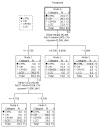Effect of 6-month caloric restriction on Cu bound to ceruloplasmin in adult overweight subjects
- PMID: 26001545
- PMCID: PMC4469556
- DOI: 10.1016/j.jnutbio.2015.03.012
Effect of 6-month caloric restriction on Cu bound to ceruloplasmin in adult overweight subjects
Abstract
In a randomized clinical trial of calorie restriction (CR), we demonstrated that important cardiovascular disease (CVD) biomarkers were favorably influenced by CR alone and in conjunction with physical exercise. The aim of this study was to examine the effects of CR with or without exercise on copper bound to ceruloplasmin (CuCp), a well-known biomarker for CVD, in overweight men and women enrolled in the CALERIE phase 1 study. Forty-six individuals were randomized to one of four groups for 6 months: control, healthy weight maintenance; CR, 25% CR from baseline energy requirements; CR+exercise, 12.5% CR and 12.5% through aerobic exercise; and low-calorie diet, low-calorie diet until 15% reduction in body weight followed by weight maintenance diet. CuCp was determined in fasting blood samples by a high-performance liquid chromatography-inductively coupled plasma mass spectrometry methodology and compared with changes in body composition and markers of CVD. After 6 months, CR combined with exercise induced a decrease in plasma concentration of CuCp. CuCp was inversely correlated with insulin sensitivity at baseline and after 6 months of intervention. A cluster analysis showed that the percent change of weight after 6 months of intervention was the most important variable that could discriminate the intervention groups. The percent change of CuCp was the only other variable selected by the analysis. Decreased CuCp in overweight subjects by CR combined with exercise suggests a positive effect of this intervention on metabolic health. Further studies to explain the relationship between weight loss and CuCp and its relevance for cardiovascular health are needed.
Keywords: Caloric restriction (CR); Cardiovascular disease (CVD); Copper bound to ceruloplasmin (CuCp); Insulin sensitivity (Si); Physical exercise (EX).
Copyright © 2015 Elsevier Inc. All rights reserved.
Conflict of interest statement
There is no conflict of interest
Figures

References
-
- Heilbronn LK, Ravussin E. Calorie restriction and aging: review of the literature and implications for studies in humans. Am J Clin Nutr. 2003;78:361–369. - PubMed
-
- Rosamond W, Flegal K, Friday G, Furie K, Go A, Greenlund K, Haase N, Ho M, Howard V, Kissela B, Kittner S, Lloyd-Jones D, McDermott M, Meigs J, Moy C, Nichol G, O’Donnell CJ, Roger V, Rumsfeld J, Sorlie P, Steinberger J, Thom T, Wasserthiel-Smoller S, Hong Y. Heart disease and stroke statistics--2007 update: a report from the American Heart Association Statistics Committee and Stroke Statistics Subcommittee. Circulation. 2007;115:e69–171. - PubMed
-
- Gu K, Cowie CC, Harris MI. Mortality in adults with and without diabetes in a national cohort of the U.S. population, 1971–1993. Diabetes Care. 2007;21:1138–45. - PubMed
Publication types
MeSH terms
Substances
Grants and funding
LinkOut - more resources
Full Text Sources
Other Literature Sources

